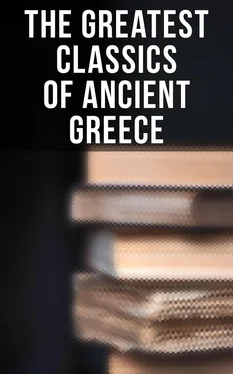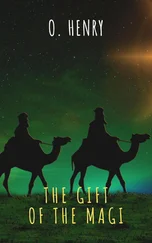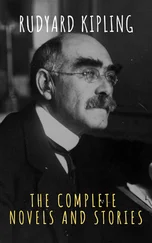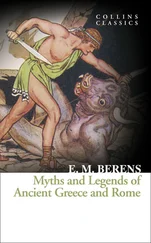He makes, perhaps, a more plausible case for his reduction of dread Persephone to a Pig. The process is curious. Early agricultural man believed in a Corn Spirit, a spiritual essence animating the grain (in itself no very unworthy conception). But because, as the field is mown, animals in the corn are driven into the last unshorn nook, and then into the open, the beast which rushed out of the last patch was identified with the Corn Spirit in some animal shape, perhaps that of a pig; many other animals occur. The pig has a great part in the ritual of Demeter. Pigs of pottery were found by Sir Charles Newton on her sacred ground. The initiate in the Mysteries brought pigs to Eleusis, and bathed with them in the sea. The pig was sacrificed to her; in fact (though not in our Hymn) she was closely associated with pigs. “We may now ask . . . may not the pig be nothing but the Goddess herself in animal form?” 64aShe would later become anthropomorphic: a lovely Goddess, whose hair, as in the Hymn, is “yellow as ripe corn.” But the prior pig could not be shaken off. At the Attic Thesmophoria the women celebrated the Descent and Ascent of Persephone,—a “double” of Demeter. In this rite pigs and other things were thrown into certain caverns. Later, the cold remains of pig were recovered and placed on the altar. Fragments were scattered for luck on the fields with the seed-corn. A myth explained that a flock of pigs were swallowed by Earth when Persephone was ravished by Hades to the lower world, of which matter the Hymn says nothing. “In short, the pigs were Proserpine.” 64bThe eating of pigs at the Thesmophoria was “a partaking of the body of the God,” though the partakers, one thinks, must have been totally unconscious of the circumstance. We must presume that (if this theory be correct) a very considerable time was needed for the evolution of a pig into the Demeter of the Hymn, and the change is quite successfully complete; a testimony to the transfiguring power of the Greek genius.
We may be inclined to doubt, however, whether the task before the genius of Greece, the task of making Proserpine out of a porker, was really so colossal. The primitive mind is notoriously capable of entertaining, simultaneously, the most contradictory notions. Thus, in the Australian “Legend of Eerin,” the mourners implore Byamee to accept the soul of the faithful Eerin into his Paradise, Bullimah. No doubt Byamee heard, yet Eerin is now a little owl of plaintive voice, which ratters warning cries in time of peril. 65No incongruity of this kind is felt to be a difficulty by the childlike narrators. Now I conceive that, starting with the relatively high idea of a Spirit of the Grain, early man was quite capable of envisaging it both spiritually and in zoomorphic form (accidentally conditioned here into horse, there into goat, pig, or what not). But these views of his need not exclude his simultaneous belief in the Corn Spirit as a being anthropomorphic, “Mother Earth,” or “Mother Grain,” as we follow the common etymology; or that of Mannhardt (ζεια ( dæa ) μητηρ=“barley-mother”). If I am right, poetry and the higher religion moved from the first on the line of the anthropomorphic Lady of the Harvest and the Corn, Mother Barley: while the popular folk-lore of the Corn Spirit (which found utterance in the mirth of harvesting, and in the magic ritual for ensuring fertility), followed on the line of the pig. At some seasons, and in some ceremonies, the pig represented the genius of the corn: in general, the Lady of the Corn was—Demeter. We really need not believe that the two forms of the genius of the corn were ever consciously identified. Demeter never was a Pig! 66
“The Peruvians, we are told, believed all useful plants to be animated by a divine being who causes their growth,” says Mr. Frazer. 67The genealogical table, then, in my opinion, is:—
Divine Being of the Grain.
|
+---------+--------------------------+
| |
( Anthropomorphized ). ( Zoomorphised ). Mother of Corn. Pig, Horse, Demeter. and so on.
Thus the Greek genius had other and better materials to work on, in evolving Demeter, than the rather lowly animal which is associated with her rites. If any one objects that animal gods always precede anthropomorphic gods in evolution, we reply that, in the most archaic of known races, the deities are represented in human guise at the Mysteries, though there are animal Totems, and though, in myth, the deity may, and often does, assume shapes of bird or beast. 68
Among rites of the backward races, none, perhaps, so closely resembles the Eleusinian Mysteries as the tradition of the Pawnees. In Attica, Hades, Lord of the Dead, ravishes away Persephone, the vernal daughter of Demeter. Demeter then wanders among men, and is hospitably received by Celeus, King of Eleusis. Baffled in her endeavour to make his son immortal, she demands a temple, where she sits in wrath, blighting the grain. She is reconciled by the restoration of her daughter, at the command of Zeus. But for a third of the year Persephone, having tasted a pomegranate seed in Hades, has to reign as Queen of the Dead, beneath the earth. Scenes from this tale were, no doubt, enacted at the Mysteries, with interludes of buffoonery, such as relieved most ancient and all savage Mysteries. The allegory of the year’s death and renewal probably afforded a text for some discourse, or spectacle, concerned with the future life.
Among the Pawnees, not a mother and daughter, but two primal beings, brothers, named Manabozho and Chibiabos, are the chief characters. The Manitos (spirits or gods) drown Chibiabos. Manabozho mourns and smears his face with black, as Demeter wears black raiment. He laments Chibiabos ceaselessly till the Manitos propitiate him with gifts and ceremonies. They offer to him a cup, like the beverage prepared for Demeter, in the Hymn, by Iambê. He drinks it, is glad, washes off the black stain of mourning, and is himself again, while Earth again is joyous. The Manitos restore Chibiabos to life; but, having once died, he may not enter the temple, or “Medicine Lodge.” He is sent to reign over the souls of the departed as does Persephone. Manabozho makes offerings to Mesukkumikokwi, the “Earth Mother” of the Pawnees. The story is enacted in the sacred dances of the Pawnees. 69
The Pawnee ideas have fallen, with singularly accurate coincidence, into the same lines as those of early Greece. Some moderns, such as M. Foucart, have revived the opinion of Herodotus, that the Mysteries were brought from Greece to Egypt. But, as the Pawnee example shows, similar natural phenomena may anywhere beget similar myths and rites. In Greece the donnée was a nature myth, and a ritual in which it was enacted. That ritual was a form of sympathetic magic, and the myth explained the performances. The refinement and charm of the legend (on which Homer, as we saw, does not touch) is due to the unique genius of Greece. Demeter became the deity most familiar to the people, nearest to their hearts and endowed with most temples; every farm possessing her rural shrine. But the Chthonian, or funereal, aspect of Chibiabos, or of Persephone, is due to a mood very distinct from that which sacrifices pigs as embodiments of the Corn Spirit, if that be the real origin of the practice.
We should much misconceive the religious spirit of the Greek rite if we undertook to develop it all out an origin in sympathetic magic: which, of course, I do not understand Mr. Frazer to do. Greek scholars, again, are apt to view these researches into savage or barbaric origins with great distaste and disfavour. This is not a scientific frame of mind. In the absence of such researches other purely fanciful origins have been invented by scholars, ancient or modern. It is necessary to return to the pedestrian facts, if merely in order to demonstrate the futility of the fancies. The result is in no way discreditable to Greece. Beginning, like other peoples, with the vague unrealised conception of the Corn Mother (an idea which could not occur before the agricultural stage of civilisation), the Greeks refined and elevated the idea into the Demeter of the Hymn, and of the Cnidian statue. To do this was the result of their unique gifts as a race. Meanwhile the other notion of a Ruler of Souls, in Greece attached to Persephone, is found among peoples not yet agricultural: nomads living on grubs, roots, seeds of wild grasses, and the products of the chase. Almost all men’s ideas are as old as mankind, so far as we know mankind.
Читать дальше












